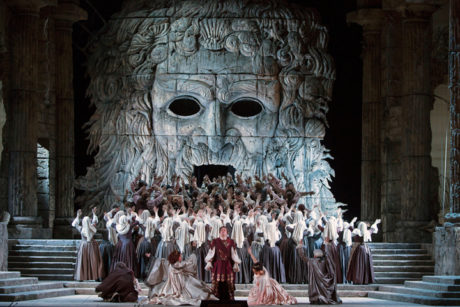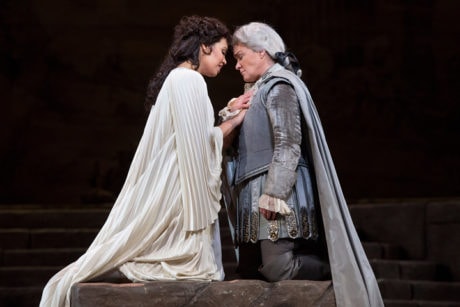Mozart’s Idomeneo is a landmark opera. It is undeniably a great achievement by a 25-year-old composer in the early stage of his career.

Unlike the later Mozart operas, Idomeneo was written in the opera seria style of an earlier age, where the subjects are noble and the movements are formal. Musical numbers follow a pattern of recitatives which advance the dramatic action, followed by arias that reflect characters’ feelings, with lengthy interjections by the chorus.
After this, the composer turned his attention to comic adventures like The Abduction from the Seraglio and then to socially-relevant dramas like The Marriage of Figaro and Don Giovanni. Eternally experimental, he produced a Viennese equivalent of vaudeville, The Magic Flute, when he was 35. Two months later he was dead.
Mozart conducted the world premiere of Idomeneo in Munich in 1781. He patterned his opera after the style of Christoph Willibald Gluck, the successful composer of eight French operas. (Although Gluck was born in Germany, he lived and worked in Paris.)
The style of Idomeneo’s choruses and marches is French, and a shipwreck scene near the end of Act One is almost identical to a scene in Gluck’s Iphigénie en Tauride, which premiered in Paris two years earlier. Gluck’s title character interrupts an instrumental storm to plead for the goddess Diane to end the tempest. In Mozart’s opera, King Idomeneo pleads for the god Neptune to do the same.
The characters portrayed by Gluck and Mozart were all associates or family members of Agamemnon after the Trojan War. Iphigénie was the sister of Elektra, Chrysothemis and Oreste; while Idomeneo was commander of the armies from Crete.
On his way back from the war, Idomeneo’s ship hits a terrible storm. He prays to Neptune and promises that he will sacrifice the first living thing he sees when he returns home if Neptune will save his ship and crew. The first living thing is his son, Idamante.
Meanwhile, Idamante has fallen in love with Ilia, daughter of the defeated Trojan King Priam, who was taken to Crete after the war.

Drama about human sacrifice horrified but fascinated audiences. Mozart built on the dark spirit of uncertainty and wrote ominous trills for the scene when Idomeneo is about to have his son killed. At the end, Neptune spares Idamante on condition that Idomeneo relinquish his throne to a new generation, and Idamante becomes the new ruler along with his bride, the sweet young Ilia.
The last act is awesome, with more personal revelations than was the norm in operas of that period. Solo oboe melodies provide poignancy. In the sacrifice chorus, “O voto tremendo”, the bass line curls around the main melody with dissonant upper and lower tones. Mozart is often thought of as a simpler, gentler predecessor of Beethoven, but in Idomeneo we hear more musical dissonances than you’ll find in any of Beethoven’s vocal works. This is quite an adventurous work, and I understand why James Levine crusaded to give it a place in the Met’s repertory.
Mozart ended the opera with a multi-part chaconne in the French manner. In his much later The Magic Flute, a festive ending is marked by loud triumphal music; and Beethoven did the same at the end of his only opera, Fidelio. But here in Idomeneo the happy celebration pauses to allow subtle passages for soft woodwinds.
Mozart composed the title role for a castrato, a man who was castrated for the purpose of making his voice high and light. For a production in Vienna in 1786, Mozart wrote some new music, and changed Idamante from a castrato into a tenor. What the Met is presenting here is an amalgam. The title role is sung by a tenor (indeed, you can’t find castrati in any opera company these days) but he sings elaborate and florid music from Mozart’s Munich score that he simplified for Vienna.
When Pavarotti and Domingo sang the role of Idomeneo at the Met, they performed the simplified version of the hero’s aria, “Fuor del mar” (“Out of the sea”); Matthew Polenzani sings the more challenging original Munich version. Polenzani’s voice lacks the metallic brilliance of those two tenors, but he brings greater sweetness and elegance, along with a mastery of the vocal ornamentation.
The young soprano Nadine Sierra was captivating as Ilia. Her voice seems small in size but has a warm quality, and she sings with grace, refinement, and nice long phrasing. Mezzo-soprano Alice Coote was the dignified Idamante, and Dutch soprano Elza van den Heever played the menacing Elettra (an alternative spelling of Elektra) who fled to Crete after the murder of her father, King Agamemnon. She too is in love with Idamante and her jealous rage against Ilia provided a show-stopping aria.
The Met orchestra played masterfully under Levine’s leadership, and the Met chorus, trained by Donald Palumbo, was fabulous. Everyone onstage moved in stylized manner on a set that was formally balanced with stairs and columns. A giant head of Neptune, with an open mouth, dominated center stage.
TV director Barbara Willis Sweete moved her cameras within the parameters of the formally balanced stage movements created by the late Jean-Pierre Ponnelle.
This was not a production to excite the passions but, rather, it earns appreciation for an interesting composition and an ensemble of elegant performances. After these HD transmissions to cinemas, the opera will be telecast on PBS stations.
Running Time: Four hours and 20 minutes, including two intermissions.

The Met: Live in HD – Idomeneo is presented in cinemas by Fathom Events and will have its final presentation on March 29, 2017. For information about future operas in HD, visit the Fathom Events website.





The production was ruined by not choosing a male tenor to play the Prince! No offence to Alice Coote & Her beautiful voice.
Mrs Tanya Freeman